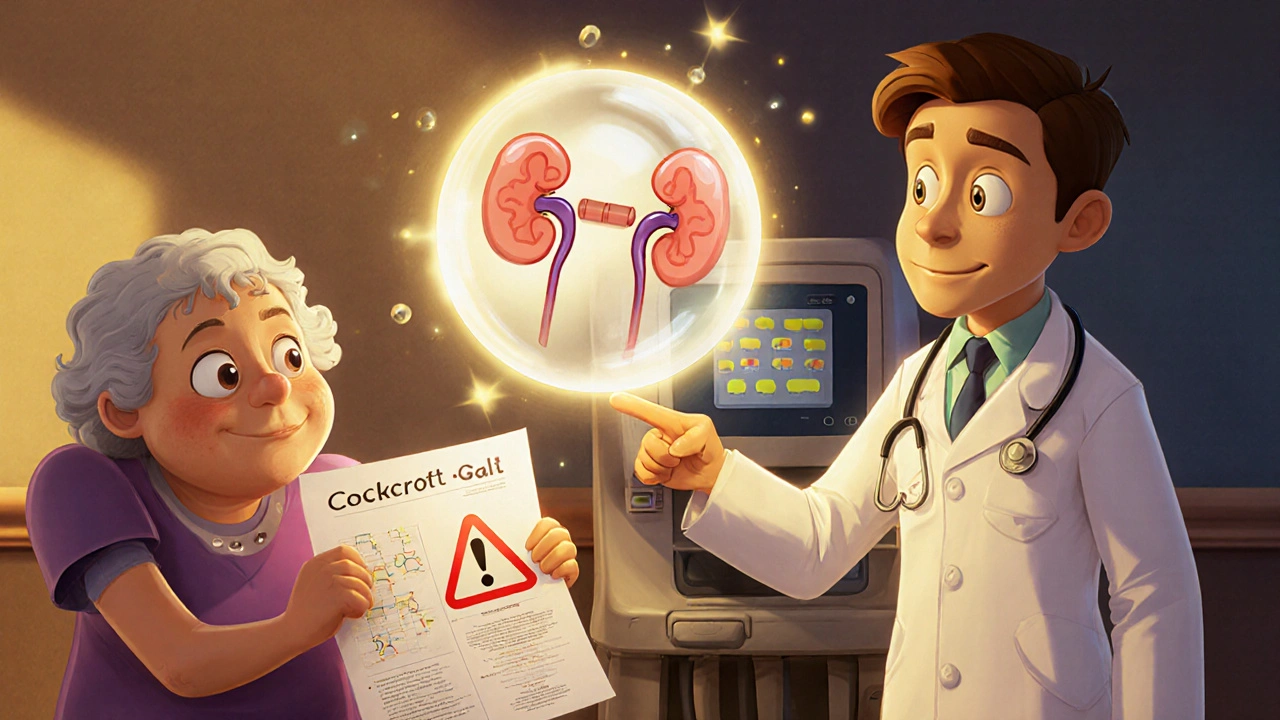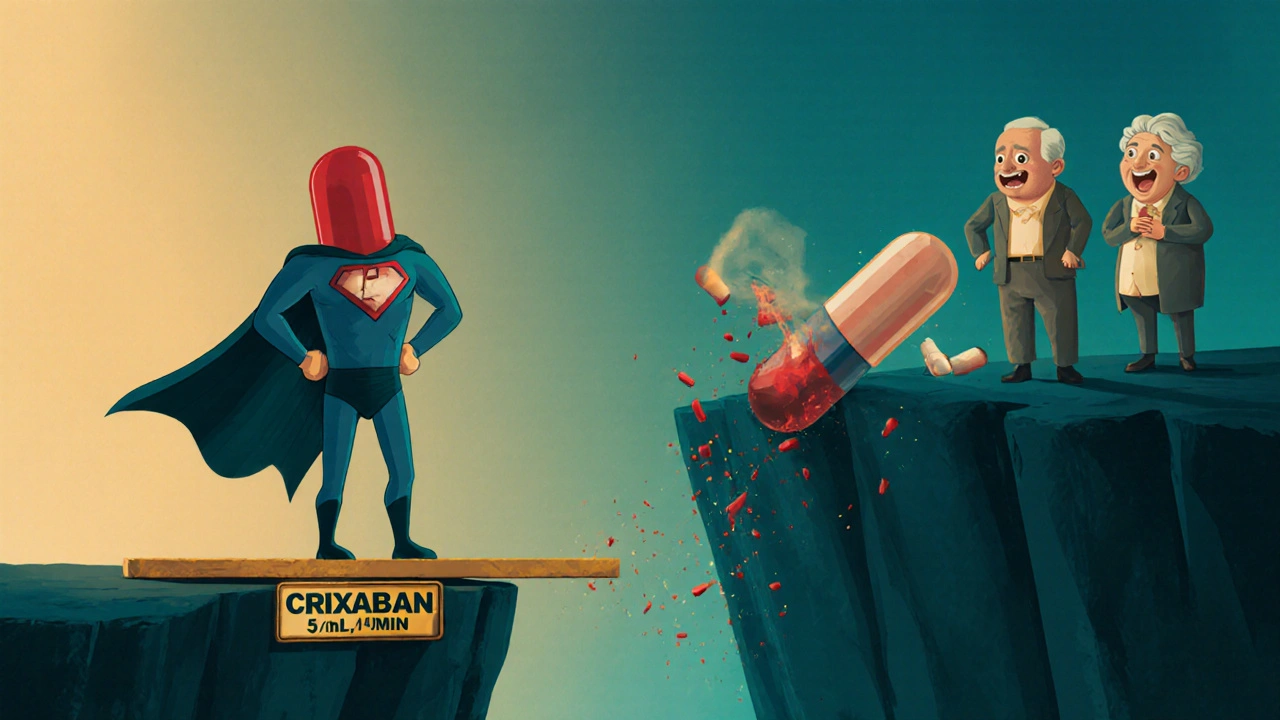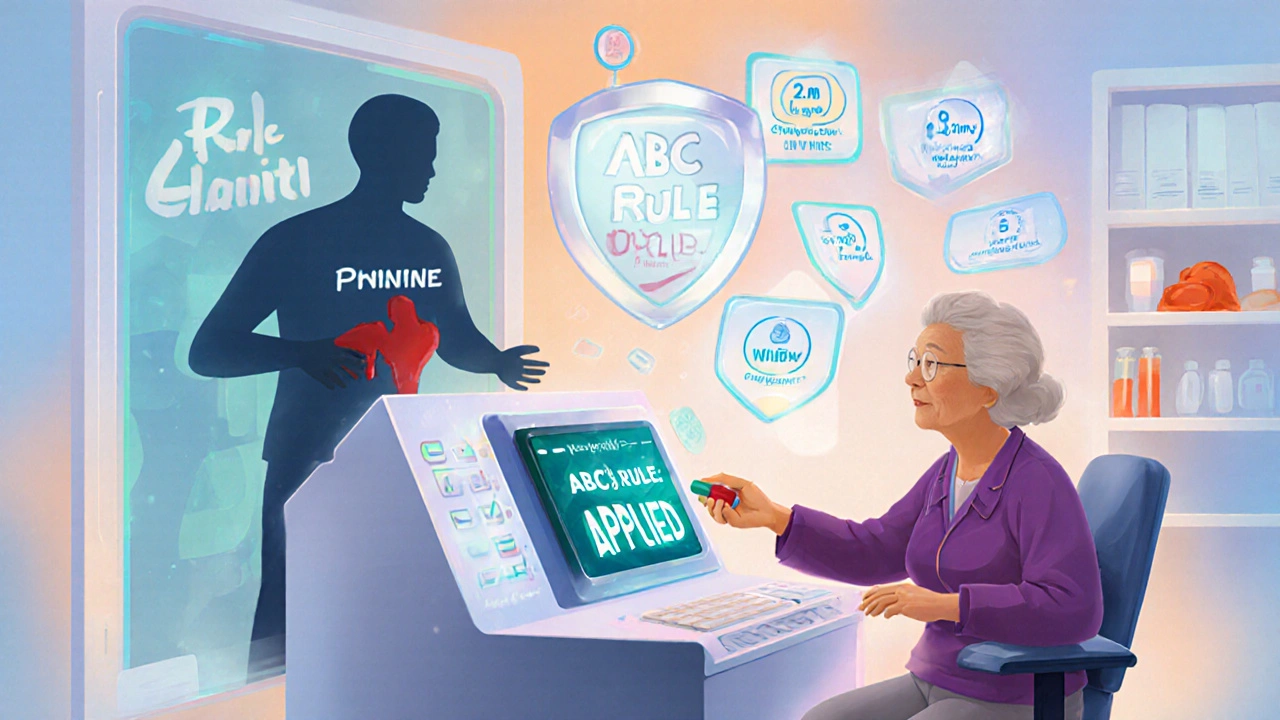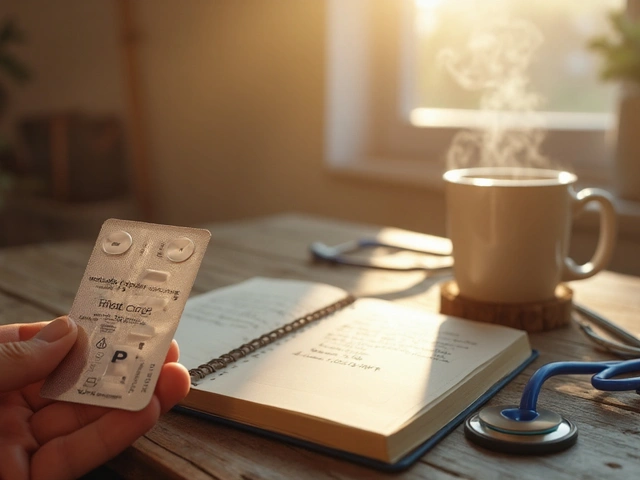DOACs in Renal Impairment: How to Adjust Dosing to Prevent Bleeding and Clots

DOAC Dosing Calculator for Renal Impairment
Enter Patient Information
Kidney Function & Dosing Recommendation
Why DOACs Are Tricky in Kidney Disease
Direct Oral Anticoagulants, or DOACs, are the go-to blood thinners for millions of people with atrial fibrillation. They’re easier to use than warfarin-no weekly blood tests, fewer food interactions, and more predictable effects. But here’s the catch: if your kidneys aren’t working well, these same benefits turn into risks. About one in three patients on DOACs have some level of kidney impairment. And if you don’t adjust the dose, you could end up bleeding internally or forming dangerous clots.
Unlike warfarin, which is broken down by the liver, DOACs like apixaban, rivaroxaban, dabigatran, and edoxaban leave the body mostly through the kidneys. When kidney function drops, the drug builds up. Too much? Higher bleeding risk. Too little? Stroke risk goes up. It’s a tightrope walk.
Which DOAC Is Safest for Poor Kidney Function?
Not all DOACs are created equal when kidneys fail. Apixaban stands out. It’s the only one with data showing it’s as safe-or safer-than warfarin even in patients on dialysis. Studies show apixaban causes less major bleeding in advanced kidney disease. That’s why many nephrologists now prefer it for patients with CrCl under 30 mL/min.
Rivaroxaban? Avoid it entirely if your CrCl is below 15 mL/min. It’s not approved for use in end-stage kidney disease. Dabigatran and edoxaban also need major dose cuts or are off-limits in severe impairment. But apixaban? Even in patients with CrCl as low as 5 mL/min, it can still be used-just at a lower dose.
Here’s the real-world difference: A 2023 study of 127 dialysis patients on apixaban 2.5 mg twice daily showed a major bleeding rate of just 1.8%. In the same group on warfarin, it was 3.7%. That’s not just statistically significant-it’s life-changing.
How to Calculate Your Kidney Function (It’s Not eGFR)
Doctors often use eGFR to check kidney health. But for DOAC dosing? That’s the wrong number. You need creatinine clearance (CrCl), calculated using the Cockcroft-Gault formula. It’s not complicated, but it’s easily missed.
Here’s the formula:
CrCl (mL/min) = [(140 - age) × weight (kg) × (0.85 if female)] / (72 × serum creatinine)
Example: A 78-year-old woman weighing 55 kg with a creatinine of 1.4 mg/dL:
(140 - 78) × 55 × 0.85 / (72 × 1.4) = 62 × 55 × 0.85 / 100.8 = 29.1 mL/min
That puts her in the reduced-dose range for apixaban. But here’s where things go wrong: many clinics still use eGFR from lab reports. That’s dangerous. eGFR overestimates kidney function in older, thinner, or frail patients. The FDA and all major guidelines say: use Cockcroft-Gault, not eGFR.

Apixaban Dosing Rules: The ABCs You Must Remember
Apixaban’s standard dose is 5 mg twice daily. But if you meet two of these three criteria, cut it to 2.5 mg twice daily:
- Age 80 or older
- Body weight 60 kg or less (about 132 lbs)
- Creatinine 133 μmol/L or higher (1.5 mg/dL)
That’s the ABC rule taught in residency programs across North America. It’s simple, memorable, and backed by data. But here’s the twist: if your CrCl is below 15 mL/min, you can’t take apixaban at all-unless you’re on dialysis. Then, 2.5 mg twice daily is still okay.
Don’t assume low weight means low dose. A 58-year-old man weighing 59 kg with normal kidneys? Still take 5 mg. Only when weight AND age OR creatinine are low does the dose drop. It’s the combination that matters.
What About Rivaroxaban, Dabigatran, and Edoxaban?
These three need stricter limits:
- Rivaroxaban: Don’t use if CrCl < 15 mL/min. Avoid in dialysis patients.
- Dabigatran: Reduce to 75 mg twice daily if CrCl is 15-30 mL/min. No use below 15 mL/min.
- Edoxaban: Cut to 30 mg once daily if CrCl is 15-50 mL/min. Not allowed below 15 mL/min.
These drugs are fine for mild to moderate kidney disease (CrCl >30 mL/min). But once you’re in the severe range, apixaban is the only DOAC with real-world safety data. Even then, it’s not a free pass. One case in a 2022 JAMA Internal Medicine study involved a 78-year-old on standard-dose apixaban who had a life-threatening GI bleed-because his weight was 58 kg and he was 81, but no one checked his creatinine. He met two ABC criteria. He should’ve been on 2.5 mg.
When Warfarin Might Still Be the Better Choice
Most people think warfarin is outdated. But in end-stage kidney disease (CrCl <15 mL/min), especially if you’re on dialysis, it’s still used in about 10% of cases. Why? Because we don’t have enough high-quality data on DOACs in this group. Some studies suggest warfarin increases bleeding and calcification in dialysis patients, but others show mixed results.
The American Heart Association still lists warfarin as an option for ESRD patients. If you’re on dialysis and your doctor suggests warfarin, it’s not because they’re stuck in the past-it’s because the evidence for DOACs here is still thin. But if you’re stable on apixaban 2.5 mg twice daily? There’s no reason to switch.

Common Mistakes and How to Avoid Them
Studies show nearly 4 out of 10 DOAC prescriptions in kidney patients are dosed wrong. Here are the top errors:
- Using eGFR instead of Cockcroft-Gault to decide dose
- Not checking weight or age when prescribing apixaban
- Prescribing rivaroxaban to someone on dialysis
- Forgetting to recheck kidney function every 3-6 months
Older adults with low muscle mass are especially risky. Their creatinine looks normal, but their actual kidney function is poor. A 90-year-old woman with a creatinine of 1.2 mg/dL might have a CrCl of only 20 mL/min. Without the right formula, she’d get the wrong dose.
Pharmacists are stepping in to help. Many hospitals now use automated alerts in their e-prescribing systems that flag when a DOAC is prescribed without a recent CrCl calculation. Some clinics have virtual anticoagulation teams that monitor labs and send alerts when doses need changing.
What’s Coming Next?
Two major trials are wrapping up in 2025. The RENAL-AF trial is comparing apixaban to warfarin in patients with severe kidney disease. The results could finally give us clear answers for CrCl 15-30 mL/min. Another study is looking at apixaban dosing in dialysis patients-something we’ve been guessing at for years.
By 2026, guidelines will likely be more precise. For now, stick to the basics: use Cockcroft-Gault, apply the ABC rule for apixaban, avoid rivaroxaban in advanced kidney disease, and recheck kidney function every few months.
Final Takeaway: Know Your Numbers, Know Your Dose
DOACs are powerful tools. But in kidney disease, they’re also dangerous if misused. The difference between a safe outcome and a hospital stay often comes down to one number: CrCl. Don’t rely on lab reports alone. Ask your doctor: "Did you use Cockcroft-Gault to calculate my creatinine clearance?" If they say no, push for it. Your life might depend on it.






Aaron Whong
November 27, 2025 AT 02:13Apixaban’s pharmacokinetic profile in renal impairment isn’t just clinically significant-it’s ontologically paradigm-shifting. The renal excretion dominance of DOACs fundamentally destabilizes the pharmacodynamic equilibrium that warfarin, with its hepatic CYP-mediated metabolism, once maintained. We’re no longer dealing with a simple dose titration problem; we’re confronting the epistemological collapse of eGFR as a surrogate marker. Cockcroft-Gault isn’t just preferred-it’s hermeneutically necessary. The very notion that a population-level estimated GFR can proxy for individual drug clearance in the elderly, cachectic, or frail is a relic of reductionist biomedicine. Apixaban’s dual dependence on weight, age, AND creatinine isn’t arbitrary-it’s a manifestation of the multivariate nature of physiological clearance. We’re moving beyond linear pharmacology into systems biology territory.
Brittany Medley
November 27, 2025 AT 19:03Just wanted to add: I’ve seen so many patients on 5mg apixaban who clearly meet two ABC criteria-age 80+, weight under 60kg, and CrCl under 1.5mg/dL-and no one ever checks the math. I once had a 79-year-old woman on 5mg twice daily, weight 52kg, creatinine 1.6, CrCl 21. She ended up in the ER with a subdural. We switched her to 2.5mg, and she’s been fine for 18 months. Please, please, please run the numbers. It’s not hard. It’s just ignored.
Cynthia Springer
November 29, 2025 AT 01:27Can someone clarify something? The post says apixaban can be used down to CrCl 5 mL/min in dialysis patients, but then says ‘if CrCl is below 15 mL/min, you can’t take apixaban at all-unless you’re on dialysis.’ So… if you’re on dialysis and CrCl is 8, you’re okay? But if you’re not on dialysis and CrCl is 8, you’re not? What’s the physiological difference that makes dialysis the deciding factor?
Rachel Whip
November 30, 2025 AT 13:20Yes, the distinction is critical. Dialysis removes apixaban intermittently-about 10-15% per session-so the drug doesn’t accumulate the same way as in non-dialysis CKD. In non-dialysis patients with CrCl <15, there’s no clearance mechanism at all. In dialysis, you get periodic ‘resetting.’ That’s why 2.5mg BID works in dialysis but is dangerous elsewhere. It’s not a loophole-it’s a pharmacokinetic safety valve.
mohit passi
December 2, 2025 AT 01:27Bro, this is why I love med posts. Real talk: I’m from India, and we’ve got tons of elderly patients with low weight, high creatinine, and no access to fancy labs. We use Cockcroft-Gault on paper napkins. Apixaban 2.5mg is our new best friend. Warfarin? Too many food issues, too many INRs flying everywhere. Apixaban’s the only thing that doesn’t make families panic every time grandma skips dal. 🙏
Sanjay Menon
December 2, 2025 AT 15:07It’s amusing how this entire discussion hinges on a 1976 formula developed before modern imaging, before CRP, before we understood inflammation’s role in renal decline. We’re clinging to Cockcroft-Gault like it’s sacred scripture, while eGFR-despite its flaws-is derived from MDRD and CKD-EPI, which are based on thousands of patients and validated across ethnicities. The fact that you’d trust a formula that doesn’t account for race, muscle mass, or body composition over actual population-based data? That’s not clinical wisdom. That’s dogma dressed in lab coats.
Micaela Yarman
December 3, 2025 AT 09:33Let’s not pretend this is just about math. This is about culture. In the U.S., we over-test, over-calculate, and still miss the point. In rural clinics, no one runs CrCl. They see ‘eGFR 30’ on the chart and assume ‘dose reduction needed.’ But eGFR 30 doesn’t mean the same as CrCl 30. The gap is dangerous. I’ve seen patients die because the lab report said ‘normal kidney function’ and no one bothered to ask: ‘Is this person 82 and 110 pounds?’ We need systems-not just knowledge.
Joe bailey
December 3, 2025 AT 21:09Big fan of apixaban here. Used to work in a dialysis unit and we switched everyone from warfarin to apixaban 2.5mg BID. Bleeds dropped by 60%. No more weekly INRs, no more vitamin K emergencies, no more patients showing up with bruising like a rainbow. The only downside? Some patients think it’s ‘too easy’ and skip doses. But that’s a behavior problem, not a drug problem. Just make sure they know: it’s not ‘light’ medicine. It’s precise medicine.
Amanda Wong
December 4, 2025 AT 09:11Apixaban is not ‘safer.’ It’s just less monitored. You’re trading one set of risks for another. Warfarin’s bleeding is detectable. Apixaban’s bleeding? Silent. No INR to panic over. No reversal agent readily available. You think 1.8% bleeding is good? Wait until it’s a cerebral hemorrhage at 3 a.m. and you can’t give andexanet alfa because your hospital doesn’t stock it. This isn’t progress. It’s convenience masked as innovation.
Marissa Coratti
December 5, 2025 AT 09:14While the data supporting apixaban in renal impairment is compelling, we must also acknowledge the structural limitations of our healthcare systems. The ABC rule is elegant, but it assumes that every clinician has access to the patient’s weight, age, and serum creatinine at the moment of prescribing-often not true in fast-paced EDs, telehealth consults, or under-resourced clinics. Moreover, the assumption that patients will self-report their weight accurately is flawed; many older adults don’t weigh themselves regularly. The real solution isn’t just better formulas-it’s integrating CrCl calculators into EHRs with mandatory alerts when two ABC criteria are met, coupled with automated dose recommendations. Without system-level intervention, even the most perfect guideline will fail in practice. We need not just knowledge, but infrastructure.